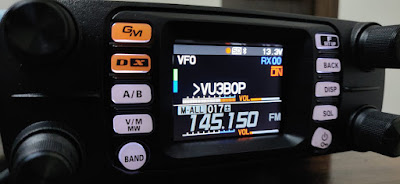Amateur Radio Station - VU3BOJ
Here I capture my Amateur Radio related experiments and learning.
Saturday, July 1, 2023
DMR: Working Talkgroup without programming channel
Thursday, June 29, 2023
GPS Roaming Zones on Anytone 878UV
GPS Roaming
Anytone releases frequent firmware updates for its most popular radio - the Anytone 878UV DMR hand held radio, mostly feature additions and bug fixes. I have not seen any other radio getting the extent of new features as this radio. Another testimony that the underlying hardware is future proof, having plenty of cpu cycles on demand.
One of the recent feature addition was GPS position based roaming feature, which basically switches the Zone based on the user position. A lot of use cases are possible, one of which is selecting the local repeaters automatically based on the location.
VU Repeater Zones
I made zones for the various VU repeaters and grouped them so they can be auto selected based on the location. Repeaters with wide coverages are included in multiple zones.
Code plug including the GPS roaming settings can be found here:
https://github.com/bejoysat/amateurradio/tree/master/digital/Anytone
The repeater channels start from 200. Zone starts from 20. This way, it will not conflict with your existing codeplug. You may use MS Excel or OpenOffice to merge the data. (Export current codeplug -> Merge -> Import again)
Further reading:
Wednesday, September 7, 2022
Programming the Yaesu FTM-300DR
It is possible to program the Yaesu FTM-300DR using the SD card transfer method. There is no need for a programming cable. Follow these steps for programming:
- Insert a blank SD card to the radio and format it. (F (long press)->SD CARD->Format)
- Backup the current memory channels to the SD card. (F (long press)->SD CARD->Backup->Write To SD->MEMORY)
- Remove the SD card and mount to the PC.
- Launch ADMS software. In the ADMS software, open the backed up file. (Communications(C)->Get Data from SD card(D)...). Locate the file MEMFTM300D.dat from SD card.
- Import the csv file containing the channels to the project. Make sure the Scan settings are set to the appropriate channels and remove the unwanted channels.
- Save the file to same location in SD card. (Communications(C)->Send Data from SD card(D)...)
- Insert the updated SD card back in radio and choose (F (long press)->SD CARD->Backup->Write To SD->MEMORY). Confirm the popup.
- The memories are written and the radio is programmed!
Download the current VU Repeaters csv file here.
References:
1. Convert Chirp format csv file to ADMS format csv file. https://github.com/bejoysat/chirp2yaesu
2. VU Repeaters for Chirp. https://raw.githubusercontent.com/bejoysat/amateurradio/master/Repeaters/VU-Repeaters-master.csv
3. FTM-300DR channels with all VU repeaters. https://raw.githubusercontent.com/bejoysat/amateurradio/master/Repeaters/FTM-300D%20VU3BOJ.csv
Digital QSL cards in Linux
Those looking for a Windows software, checkout PA4M Digital QSL Creator.
I like Linux and uses it as a daily driver for anything other than day job. So when I participated in a contest recently, I thought of sending out digital QSL cards to my contacts. Upon searching online, I found it is possible using Linux. Nothing to be invented. Here is how I went about:
Made sure that the original log for the contest is maintained in spreadsheet and can be exported to a csv file.
Design a QSL card. This needs a little patience. There are templates available online, mostly for Adobe Photoshop. I wanted to create in GIMP and started from scratch.
While designing the card, I followed the guidelines found here, regarding the card size, so that the same can be printed if necessary.
The template GIMP project I created can be found here.
After the QSL card image was created, I used glabels software (similar to MailMerge in MS Word) to generate individual QSL card images. I used a workflow found here.
The glabels project I used is also available in the github project.
Once the contest log csv is tied to the glabels software, the QSL card images can be saved to a file. This will be a single multi page pdf file.
Now, the pdf file is converted to individual .png files using the following command:
pdftoppm -png output.pdf qslcard
This will create individual files and can be renamed to <callsign>.png using a script.
python rename-qsl-files.py finallog.csv qslcard png
Now all the individual images files are available and it is ready to be sent out to the recipients. The email ids of the stations are fetched from QRZ.com, again using a python script. (QRZ subscription needed to get email id field)
The script is also available in the github location.
That is mostly the workflow. Someday, I will improve the script to get everything done in a single command.
References:
1. https://rsgb.org/main/operating/qsl-bureau/what-is-a-qsl-card/
2. https://github.com/bejoysat/amateurradio/tree/master/qslcard
3. https://oe5lxr.at/automate-your-qsl-card-workflow/
Friday, July 8, 2022
Upload LOTW log via command line
tqsl -d -u -a all -x -l "Home" /home/bejoy/.local/share/WSJT-X/wsjtx_log.adiHere is the equivalent command for Windows
tqsl -d -u -a all -x -l "Home" "C:\Users\INTEL\AppData\Local\JTDX\wsjtx_log.adi"
The "Home" in the above command is the station location as seen in the TQSL application. See reference in the below screenshot.
More information about the command and its arguments are available in LOTW website. http://www.arrl.org/command-1
VU Repeater Map
Repeater map of India










